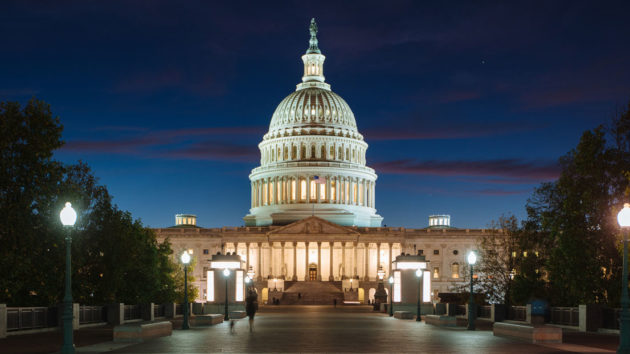Congress Blew Through the Budget Caps, Again. Here’s What Needs to Change.
The Bipartisan Budget Act of 2018 signed into law last week really should be renamed the Bipartisan Budget Crash Act.
This spending spree takes a Mack Truck and rams through the hard-fought budget caps under the 2011 Budget Control Act to the tune of at least $300 billion.
When all is said and done, the fiscal wreckage could be worse than that. With a federal debt already at $20.5 trillion, we have just lurched closer to fiscal insolvency.
Republicans touted that they got $1 of new military spending for every $1 of domestic social programs, but even that is wishful thinking at best. This calculation doesn’t include emergency disaster spending for hurricanes and fires, which was close to $90 billion. At least $21 billion of “defense” spending goes to the State Department instead, which does not fight wars.
In the end, the domestic agencies may wind up with $2 of added funding for every $1 for national security, which is hardly a good deal for taxpayers.
It also isn’t clear why the recovery efforts to pay for disaster relief should be paid for by the federal government.
In the wake of some of the worst disasters in American history—the hurricane that wiped out Galveston, Texas, the Great Chicago Fire, and the San Francisco earthquake, for example—the rebuilding of these cities happened swiftly and was almost all funded by private businesses, private charities, and state and local initiatives, not by Washington writing a big check.
And when, alas, the feds do write big checks for disasters, the money should come from across-the-board cuts of 2 or 3 percent from all the other federal agencies—not by running up the debt.
The Budget Control Act caps are now a victim of their own success. From 2011-2016, the spending caps held discretionary spending increases below the 2 percent level of inflation. For three years, federal spending actually fell, in no small part because of those caps.
But now those tight caps have been evaded four times in six years, and each time the overspending has been larger. The cork has been pulled off the champagne bottle.
The lack of spending restraint and the inability of Congress to keep its past legislative promises not only erodes trust in the political class, but shows a frightening and complete indifference by Washington toward our nation’s growing fiscal crisis.
The big question is, where do we go from here on the budget?
With neither party at all committed to reducing debt and deficits, our worry is that the budget caps are, for all intents and purposes, gone forever.
The caps after 2020 are still technically in place, but the 2019 levels of spending are going to come in at as much as $200 billion above the 2020 caps. So either we see a massive cut in government spending in the election year of 2020, which would be a wonderful thing to behold—but is as likely as President Donald Trump and House Minority Leader Nancy Pelosi dancing a tango together—or, Congress throws the caps into the dustbin of history.
That’s a scary prospect, because it would mean that Congress would be budgeting without any fiscal guard rails or speed limits at all. This will only invite further bipartisan spending sprees that are against the interests of the American people.
The indefensible budget behavior of Congress over the last several weeks reinforces the case for Congress to extend the Budget Control Act caps into 2022 and beyond, since the caps expire at the end of 2021.
These future caps should be based on the 2011 Budget Control Act’s average annual spending growth rate, not the new budget’s enormous spending growth rate. Failure to extend the caps would be a total surrender and a green light to the already out-of-control Mack Truck.
COMMENTARY BY
Stephen Moore
Stephen Moore, who formerly wrote on the economy and public policy for The Wall Street Journal, is a distinguished visiting fellow for the Project for Economic Growth at The Heritage Foundation. He was also a senior economic advisor to Donald Trump during the 2016 presidential campaign. Read his research. Twitter: @StephenMoore.
Christian Andzel
Christian Andzel is a member of the Young Leaders Program at The Heritage Foundation.
A Note for our Readers:
Trust in the mainstream media is at a historic low—and rightfully so given the behavior of many journalists in Washington, D.C.
Ever since Donald Trump was elected president, it is painfully clear that the mainstream media covers liberals glowingly and conservatives critically.
Now journalists spread false, negative rumors about President Trump before any evidence is even produced.
Americans need an alternative to the mainstream media. That’s why The Daily Signal exists.
The Daily Signal’s mission is to give Americans the real, unvarnished truth about what is happening in Washington and what must be done to save our country.
Our dedicated team of more than 100 journalists and policy experts rely on the financial support of patriots like you.
Your donation helps us fight for access to our nation’s leaders and report the facts.
You deserve the truth about what’s going on in Washington.
Please make a gift to support The Daily Signal.
EDITORS NOTE: The featured image is by erick4x4/Getty Images.




How about balancing the budget in the following manner: 1’st up: DoD – Defend these shores, or its game over. 2) Pay back every cent of interest. 3) Start funding all other parts of Government except HHS. 4) Give HHS (Social Security and Medicare mostly) whatever fraction is left. If that is 10 cents on the dollars be it. People are going to scream bloody murder when their SS check is reduced 90%, and Medicare suddenly cannot pay for that hip replacement. Then there will be an opportunity to explain to people that you can’t get blood out of a turnip.